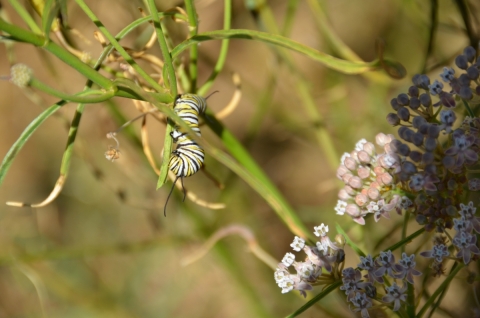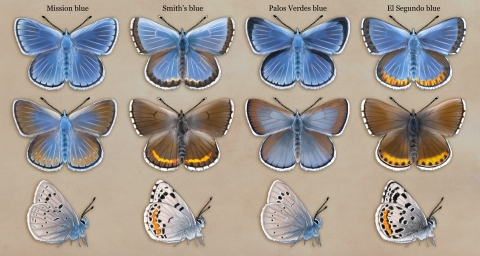Hey, California! Grab some binoculars and a smart phone, because it's Pollinator Week. And what better way to celebrate than by catching up with pollinator royalty – butterflies.
Let’s start with a fan favorite.
The “Beyoncé” of butterflies
Thousands of monarchs historically migrate to coastal California each year, clustering in the trees to overwinter. But over the past two decades monarch numbers have declined. The Service takes an all-hands-on-deck approach to save the species, and partners with federal, state and local agencies, Tribes, Non-governmental agencies, and private citizens on conservation efforts.
So, what’s going on?
The Carlsbad Fish and Wildlife Office's Partners for Fish and Wildlife Program collaborated with the San Diego Pollinator Alliance, Resource Conservation District of Greater San Diego County, Earth Discovery Institute, S&S Seeds, the U.S. Marine Corps, and local nurseries to make native milkweed (narrowleaf milkweed, Asclepias fascicularis) available to the Southern California public to create monarch habitat. The partnership collected seeds from a wild site on Marine Corps Base Camp Pendleton in San Diego County for S&S Seeds to grow at their native seed farm.
For more information about the project and to request seeds, visit rcdsandiego.org/education/milkweed-for-monarchs/sandiegonativemilkweedproject.
The Ventura Fish and Wildlife Office partnered with the University of California, Santa Barbara Bren School of Environmental Science & Management to help save the monarch. Although non-native, tropical milkweed is popular, it is a threat to western monarch populations. The students developed informational materials for nurseries and consumers about the importance of sourcing and planting native milkweed and nectar plants.
The Sacramento Fish and Wildlife Office helped Beale Air Force Base build a pollinator garden in 2017, and it has become quite the monarch hot spot. The base’s large areas of undeveloped habitat provide essential resources for the hundreds of breeding and migrating monarchs that visit March through October. The garden’s native plants include creeping sage, buckwheat, coyote bush, rabbit bush, and three species of wild milkweed.
But wait, there’s more. The pollinator party continues with some celebrity lookalikes.
Who wore it best
California's coast is home to several striking blue butterflies in the Lycaenidae family. At first glance it might seem like they all look the same, and it’s hard to know which one is which. However, they each have distinct wing patterns and are found in different parts of the state.
Take a StoryMap tour of these beauties and discover more about their unique markings and habitat range to see if you can spot any in your area.
Everyone can play a role in pollinator survival and recovery. Join the conservation effort today!
How to help
- Plant a pollinator garden.
- Become a citizen scientist and help scientists track population numbers to better understand wildlife and habitat conditions.
- Learn more about California butterflies through fun art activities.








